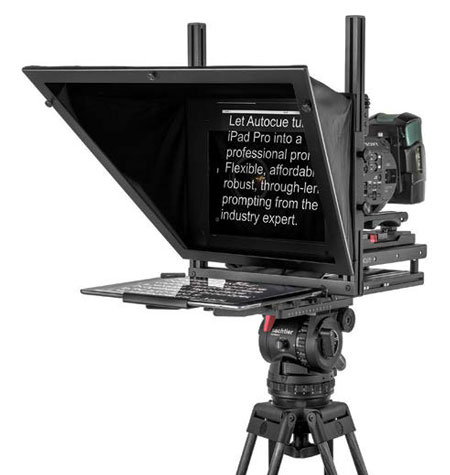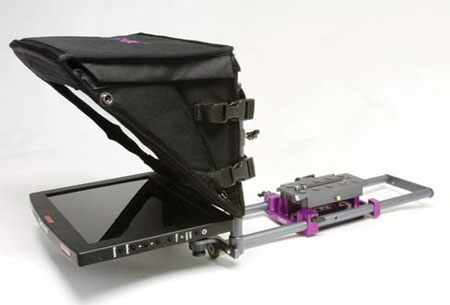Prompters Rely on Brightness, Flexibility
OTTAWA—Judging by the products teleprompters manufacturers introduced at the 2016 NAB Show, today’s TV stations want prompters that can run on low-cost platforms like iPads, yet can stand up to the brightest light that the sun can throw at them.
DESIGNED FOR THE LARGER IPAD
Autocue has updated its prompting solutions designed specifically for the Apple iPad Pro. The company (a Vitec Videcom brand) is pitching its existing Starter Series iPad Teleprompter for the 9.7-inch iPad Pro, while the latest update to the Starter Series is being targeted to users of the 12.9-inch iPad Pro. Both come with camera hood mounts and angled glass that allow either unit to reflect its text directly in front of the camera lens; allowing talent to read while looking into the camera.

Autocue’s iPad Pro Prompter is compatible with both the 9.7-inch and new 12.9-inch models. The 12.9-inch model was just introduced onto the market earlier this year and its larger size makes it more versatile for broadcast operations, according to Robin Brown, product manager for Autocue/Autoscript. “For the talent to use [the 9.7 inch iPad Pro] as a prompter, the equipment has to be six feet or closer,” he said. “When you use the 12.9-inch iPad Pro, its larger screen allows the camera to be as far as 15 feet away from the talent, while the text remains readable. This makes the 12.9-inch version practical for most TV production studios.” The 12.9-inch version of Autocue’s Starter Series iPad Teleprompter also allows text speed and direction to be controlled using an iPad/iTouch device, or an optional wired remote.
Autocue has also announced that it has adopted NewTek’s open Network Device Interface (NDI) standard, for IP-based production workflows associated with Autocue’s QStart Prompting Software. “With NDI enabled, Autocue’s QStart is recognized as a source by other NDI-enabled devices and systems connected to a standard Ethernet local area network,” said Brown. “This exponentially increases the number of video sources available for live production without the need for a physical input or output.”
Vitec Videocom’s Autoscript used the NAB Show to announce that it has created an “original automated newsroom workflow” in partnership with Sony. The new system merges Autoscript’s Winplus teleprompting software and Sony’s ELC (Enhanced Live Control) system. ELC is a live production system that manages all newscast functions—cameras, graphics, playout servers, and other sources—from a single operator position. The new partnership provides ELC with Autoscript’s prompting capabilities, with the company’s WinPlus software giving the operator control of the script feed/speed, and the prompter rundown.
“Putting Winplus teleprompting together with Sony’s ELC makes it possible for one person to live-produce a newscast that is professional, polished, and flexible,” said Brown

Cuesript’s CSP10S prompter systemRIBBON-STYLE MENU
Cuescript used the NAB Show to mark the U.S. debut of its family of CueiT prompting software for video producers and broadcasters. The company also unveiled its new CSP10S prompter system, which is designed for use with jibs, cranes, and mobile broadcast applications.
The professional video industry's #1 source for news, trends and product and tech information. Sign up below.
CueiT employs a “ribbon-style menu,” so that the system’s onscreen features are viewable at all times without blocking the script and run order. It also uses commands and features that can be accessed from multiple sources during live broadcasts, and markers to let the prompting operator set up their own “sub-run order and pinpoint positions,” allowing them to move through the script in ways that make sense to them. CueiT comes with multi-language and full bidirectional ability within a script, and is available in CueiT Premier for the entry-level market, CueiT Production and CueiT News.
CSP10S comes with a collapsible hood and prompter glass that can clear the shot of a 4:5 lens, or the monitor can be rigged as a straight reading system without any additional hardware. The built-in cue lights change orientation automatically and the 10.4-inch screen boasts a 2000 nits brightness screen, meaning that it can be read in the brightest sunlight outside.
DEFEATING THE GLARE
Field teleprompters are becoming increasingly popular with TV stations who want their reporters to be as poised speaking to camera in the middle of nowhere, as they are when in studio. The only downside is that field prompters have to stand up against the glare of the sun, which can wash out the prompter’s reflective glass and leave the talent ad-libbing.
Mirror Image Teleprompters in Oshkosh, Wis., has addressed this problem with the release of its LC-120 (12-inch LCD) and LC-170 (17-inch LCD) field prompters. Both portable units output 1000 nits of screen brightness to blaze their text through the sun’s glare; and both can accept composite, HDMI, SDI, and VGA inputs.
“We have had several customers who purchase an iPad teleprompter with the intent of using it in the field, only to find that the sun washes out the tablet’s screen,” Mike Burdick, sales manager for Mirror Image. “We have been relaying this observation to all new iPad teleprompter customers as well, just in case they planned to use the prompter in the same way.”
Burdick noted that Mirror Image has updated its product line to accept both HDMI and SDI signals “that are being utilized so much more in the industry,” he said. “In changing our LCD monitors to accept these inputs, we also made them early three times as bright as they were before.”
James Careless is an award-winning journalist who has written for TV Technology since the 1990s. He has covered HDTV from the days of the six competing HDTV formats that led to the 1993 Grand Alliance, and onwards through ATSC 3.0 and OTT. He also writes for Radio World, along with other publications in aerospace, defense, public safety, streaming media, plus the amusement park industry for something different.

